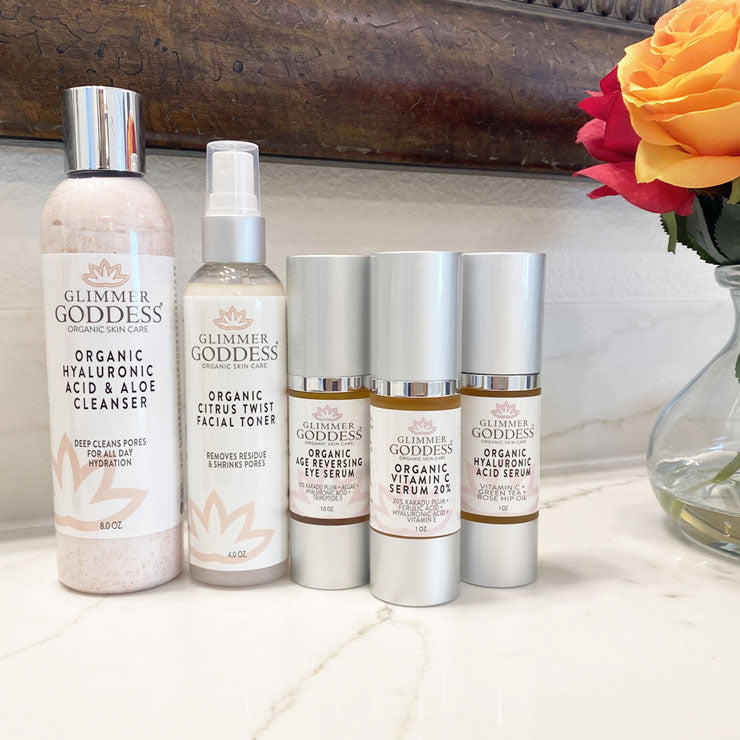
Unlocking Radiance: The Battle of Chemical vs. Physical Exfoliation for Mature Skin
As we age, our skin undergoes significant changes, leading to a dull appearance and fine lines. Understanding the best exfoliation methods, chemical and physical, is essential for maintaining a radiant complexion. This article dives into the benefits of each exfoliation method and how they can be tailored to meet the unique needs of mature skin.
Unlocking the Secrets of Radiant Skin: A Journey Through Aging and Exfoliation
What Happens to Our Skin as We Age?
As we grow older, our skin undergoes a remarkable transformation. The once supple and youthful complexion gradually gives way to a more mature appearance, marked by wrinkles, fine lines, and a loss of elasticity. Understanding the intricate mechanisms behind this natural process is the key to maintaining a healthy, glowing complexion.
The Age-Old Story of Skin Aging
- The primary culprit behind skin aging is the gradual breakdown of collagen and elastin, the two key structural proteins that provide our skin with its firmness and resilience.
- As we age, the body's natural production of these proteins slows down, leading to a loss of skin's plumpness and the emergence of wrinkles and sagging.
- Additionally, the skin's ability to retain moisture diminishes, resulting in a drier, more dehydrated appearance.
- Exposure to environmental factors, such as UV radiation, pollution, and smoke, can further accelerate the aging process, contributing to premature wrinkles and age spots.
How Does Exfoliation Enhance Skin Health?
Exfoliation, the process of removing dead skin cells from the surface, is a powerful tool in maintaining a youthful, radiant complexion. By uncovering the fresh, healthy skin underneath, exfoliation can work wonders in revitalizing the skin and promoting a more even, glowing appearance.
The Rejuvenating Power of Exfoliation
- Regular exfoliation helps to slough off the accumulation of dead skin cells, which can dull the skin's appearance and clog pores.
- By removing this layer of dead cells, exfoliation allows for better product penetration, ensuring that moisturizers, serums, and other skincare treatments can effectively nourish the skin.
- Exfoliation also stimulates the skin's natural cell turnover process, encouraging the production of new, healthy skin cells.
- This accelerated cell renewal can help to minimize the appearance of fine lines, wrinkles, and discoloration, resulting in a more youthful, luminous complexion.
Why Mature Skin Needs Special Care in Exfoliation?
As we age, our skin's needs and tolerance levels change, requiring a more nuanced approach to exfoliation. Mature skin, with its delicate and often dehydrated nature, demands specialized techniques and products to ensure the exfoliation process remains gentle and effective.
Navigating the Exfoliation Needs of Mature Skin
- Mature skin is more prone to sensitivity and can be easily irritated by harsh exfoliating methods. Using gentler, more nourishing exfoliants is essential to avoid causing further damage.
- Chemical exfoliants, such as alpha-hydroxy acids (AHAs) and beta-hydroxy acids (BHAs), can be an excellent choice for mature skin, as they dissolve the bonds between dead skin cells without causing physical abrasion.
- Incorporating moisturizing and soothing ingredients, like hyaluronic acid and ceramides, can help to counteract any potential dryness or irritation caused by exfoliation.
- Adjusting the frequency of exfoliation is crucial, as older skin may require less frequent but more targeted treatments to maintain a healthy, radiant glow.
Unlocking the secrets of radiant skin is a lifelong journey, one that requires a deep understanding of the skin's changing needs as we age. By embracing the power of gentle exfoliation and tailoring our routines to the unique requirements of mature skin, we can unlock the path to a more youthful, luminous complexion that defies the passage of time.
The Revolutionary Power of Chemical Exfoliants for Vibrant, Youthful Skin
What Are the Different Types of Chemical Exfoliants?
Chemical exfoliants are a game-changer in the world of skincare, offering a powerful yet gentle way to reveal radiant, rejuvenated skin. These powerful ingredients work by dissolving the bonds that hold dead skin cells together, allowing them to slough off and reveal the smooth, luminous complexion hiding underneath.
There are several types of chemical exfoliants, each with its own unique benefits and suitable for different skin types:
- Alpha Hydroxy Acids (AHAs): AHAs like glycolic acid, lactic acid, and mandelic acid are water-soluble and work by dissolving the "glue" that holds dead skin cells together. They're excellent for improving skin texture, reducing the appearance of fine lines and wrinkles, and brightening the complexion.
- Beta Hydroxy Acids (BHAs): Salicylic acid is the most well-known BHA, and it's oil-soluble, allowing it to penetrate deep into the pores to unclog them and reduce the appearance of blackheads and blemishes. BHAs are particularly beneficial for those with oily, acne-prone skin.
- Polyhydroxy Acids (PHAs): PHAs like gluconolactone and lactobionic acid are larger molecules that don't penetrate the skin as deeply as AHAs and BHAs. This makes them a gentler option, suitable for those with sensitive skin or who are new to chemical exfoliation.
What Benefits Can Chemical Exfoliants Offer to Mature Skin?
As we age, our skin's natural cell turnover slows down, leading to a build-up of dead skin cells and a dull, uneven complexion. This is where chemical exfoliants can step in and work their magic.
Chemical exfoliants offer a multitude of benefits for mature skin:
- Improved Skin Texture: By dissolving the bonds that hold dead skin cells together, chemical exfoliants reveal a smoother, more youthful-looking complexion.
- Reduced Appearance of Fine Lines and Wrinkles: The exfoliating action of these ingredients can help to minimize the appearance of fine lines and wrinkles by stimulating collagen production and cell renewal.
- Diminished Age Spots and Discoloration: Many chemical exfoliants, especially AHAs, can help to fade age spots and other signs of sun damage, resulting in a more even, radiant skin tone.
- Enhanced Absorption of Other Skincare Products: By removing the buildup of dead skin cells, chemical exfoliants allow other skincare products to penetrate more effectively, amplifying their benefits.
How to Safely Incorporate Chemical Exfoliation into Your Routine?
Introducing chemical exfoliants into your skincare routine requires a bit of caution, especially for those with sensitive or mature skin. However, with the right approach, you can safely and effectively reap the benefits of these powerful ingredients.
Here are some tips to help you incorporate chemical exfoliation into your routine safely:
- Start Slow: Begin with a low-concentration product and use it only a few times per week, gradually increasing the frequency and strength as your skin adjusts.
- Patch Test: Before using a new chemical exfoliant, always do a patch test on a small area of skin to ensure your skin can tolerate it.
- Prioritize Hydration: Chemical exfoliants can be drying, so be sure to follow up with a nourishing moisturizer to keep your skin balanced and healthy.
- Protect Your Skin: After using a chemical exfoliant, be diligent about using sunscreen, as your skin will be more sensitive to UV exposure.
- Listen to Your Skin: If you experience excessive redness, irritation, or dryness, reduce the frequency or strength of your chemical exfoliant, or discontinue use altogether.
Chemical exfoliants are a transformative skincare tool that can help you achieve a brighter, more youthful complexion. By understanding the different types of exfoliants and how to use them safely, you can unlock the key to radiant, rejuvenated skin at any age.
The Power of Physical Exfoliation: Unlocking Radiant Skin
What are Common Physical Exfoliants and How Do They Work?
Physical exfoliation is a skincare technique that has been used for centuries to remove dead skin cells and reveal a brighter, smoother complexion. This process involves the use of small, abrasive particles or tools to physically scrub away the top layer of the skin. Some of the most common physical exfoliants include:
Facial Scrubs
- Facial scrubs contain small, granular particles such as crushed walnut shells, sugar, or salt that help to physically slough off dead skin cells.
- The abrasive action of these particles helps to smooth and refine the skin's texture, leaving it feeling refreshed and revitalized.
- Facial scrubs are typically used 1-2 times per week, depending on your skin type and sensitivity.
Konjac Sponges
- Konjac sponges are made from the root of the Konjac plant, a natural, soft, and gentle exfoliating tool.
- When used with water, the sponge expands and gently buffs away dead skin cells, leaving the skin feeling clean and radiant.
- Konjac sponges are a great option for those with sensitive skin, as they provide a gentle exfoliation without causing irritation.
Dry Brushing
- Dry brushing involves using a natural-bristle brush to lightly scrub the skin in circular motions, typically starting from the feet and moving upwards towards the heart.
- This technique helps to stimulate the lymphatic system, improve circulation, and remove dead skin cells, resulting in a more even, smooth complexion.
- Dry brushing should be done before showering, as it can help to prepare the skin for deeper cleansing and absorption of other skincare products.
Are There Risks Associated with Physical Exfoliation?
While physical exfoliation can be a highly effective way to achieve radiant, healthy-looking skin, it's important to be mindful of potential risks and take precautions to ensure safe and effective use.
Skin Irritation and Sensitivity
- Overzealous or too-frequent physical exfoliation can lead to skin irritation, redness, and even microtears in the skin.
- Those with sensitive skin or certain skin conditions, such as rosacea or eczema, may be more prone to irritation and should use physical exfoliants with caution.
Disruption of the Skin Barrier
- Aggressive physical exfoliation can disrupt the skin's natural barrier, leaving it more vulnerable to environmental stressors and potential infection.
- This can lead to increased dryness, inflammation, and even accelerated signs of aging.
Potential for Infection
- If physical exfoliants are not used properly or if the skin is already compromised, there is a risk of introducing bacteria and potentially causing infections.
- It's important to always use clean, sanitized tools and to avoid exfoliating any areas with open wounds or active breakouts.
When and How Often Should You Exfoliate Physically?
Determining the optimal frequency and technique for physical exfoliation is crucial to achieving the best results while minimizing potential risks. Here are some guidelines to consider:
Skin Type and Sensitivity
- Those with normal to oily skin may be able to tolerate physical exfoliation 1-2 times per week.
- Individuals with dry, sensitive, or aging skin may need to limit physical exfoliation to 1-2 times per month to avoid overstressing the skin.
Time of Year
- During the colder, drier months, the skin may be more prone to dryness and irritation, so it's best to reduce the frequency of physical exfoliation.
- In the warmer, more humid months, the skin may be able to handle more frequent physical exfoliation to address buildup of dead skin cells.
Exfoliation Technique
- Gentler physical exfoliants, such as Konjac sponges or mild facial scrubs, can be used more frequently (1-2 times per week) without causing excessive irritation.
- Harsher physical exfoliants, like dry brushing or coarse facial scrubs, should be used more sparingly (1-2 times per month) to avoid damaging the skin's delicate barrier.
Incorporating physical exfoliation into your skincare routine can be a powerful way to achieve a radiant, youthful-looking complexion. However, it's crucial to listen to your skin's unique needs, understand the potential risks, and use physical exfoliants with care and moderation. By finding the right balance, you can unlock the transformative power of physical exfoliation and enjoy the benefits of smooth, glowing skin.
Q&A
What is the difference between chemical and physical exfoliation?
Chemical exfoliation uses active ingredients to dissolve dead skin cells, while physical exfoliation involves scrubbing away dead cells through manual methods such as scrubs or sponges.
How often should I exfoliate mature skin?
Mature skin should be exfoliated carefully, with chemical exfoliants used 1-3 times a week, while physical exfoliants should be limited to 1-2 times per month to avoid irritation.
What are the benefits of chemical exfoliation for aging skin?
Chemical exfoliation helps even out skin tone, reduce fine lines and wrinkles, and enhance product absorption, promoting a more youthful and radiant complexion.
Can physical exfoliants irritate sensitive skin?
Yes, physical exfoliants can cause irritation, especially for sensitive skin types. It's important to choose gentle options and avoid excessive scrubbing.
What ingredients should I look for in chemical exfoliants for mature skin?
For mature skin, look for products containing alpha-hydroxy acids (AHAs) like glycolic and lactic acid, as well as beta-hydroxy acids (BHAs) like salicylic acid for effective exfoliation without physical abrasion.
In the quest for youthful, radiant skin, both chemical and physical exfoliation have unique benefits and considerations. Mature skin requires careful attention, and by properly utilizing these exfoliation methods, you can unlock healthier, more luminous skin at any age.







